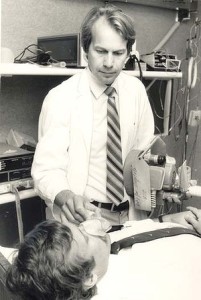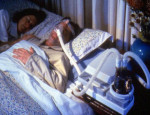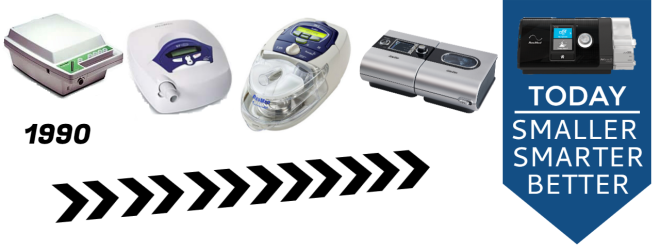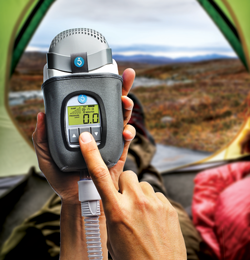Most people are surprised when they learn that CPAP technology has only been around for about 35 years. Starting off as cobbled together vacuum cleaner parts in a laboratory, the CPAP machine has slowly become an ultra-advanced and intuitive machine that battles sleep apnea and eliminates symptoms while you rest comfortably. Much of this evolution is due in part to the innovative spirit of CPAP manufacturers, but a lot of it actually has to with CPAP sufferers like yourself, who – over the years – have honed and tailored the technology through personal use.
Surgery Only Option Before CPAP
 Before CPAP, a widely used therapy option for severe obstructive sleep apnea was surgery. They would put you under and surgically remove the part of your respiratory system that was causing the blockage. In some particularly severe cases, doctors would create a permanent tracheostomy. The problem with this surgery was that it was invasive and had a lot of risks. Thankfully, Colin Sullivan came along with a solution. His experiments using a pressurized air machine that he made out of a vacuum cleaner motor proved to be successful on dogs – and it would soon prove to be successful on people too.
Before CPAP, a widely used therapy option for severe obstructive sleep apnea was surgery. They would put you under and surgically remove the part of your respiratory system that was causing the blockage. In some particularly severe cases, doctors would create a permanent tracheostomy. The problem with this surgery was that it was invasive and had a lot of risks. Thankfully, Colin Sullivan came along with a solution. His experiments using a pressurized air machine that he made out of a vacuum cleaner motor proved to be successful on dogs – and it would soon prove to be successful on people too.
In fact, the invention of the CPAP machine – as Dr. Sullivan’s machine would soon be called – would start to save people’s lives. In the beginning, CPAP masks were customized according to the patient’s face using a plaster mold – the mold would then be turned into a fiberglass mask. Tiny air inlets would be placed in the fiberglass and tubes would be placed through those holes. The mask was then attached with a silicone adhesive so that it didn’t slip off over night. This was in 1981, and while the CPAP machines used were prehistoric compared to today’s machines, the therapy had revolutionary results.
Humidification Innovation
 Over the years, CPAP machines started taking shape as the go to treatment option for obstructive sleep apnea. The first machines were very large, heavy and noisy. Though they provided much needed relief, they lacked convenience. The early machines such as the Sullivan CPAP, name after the CPAP inventor, lacked even simple comfort features like humidification, a feature today most people can’t live without. Eventually, an external humidifier was introduced. A tube connected the CPAP to the humidifier and then another tube connected the humidifier to you mask, making the CPAP setup more unwieldy. Then humidifier units that attached to the CPAP were finally introduced in 1995 so you just had one tube making the design more minimal. Now the newest models have a completely integrated humidifier, meaning it is a standard part of the machine and takes up barely any space at all.
Over the years, CPAP machines started taking shape as the go to treatment option for obstructive sleep apnea. The first machines were very large, heavy and noisy. Though they provided much needed relief, they lacked convenience. The early machines such as the Sullivan CPAP, name after the CPAP inventor, lacked even simple comfort features like humidification, a feature today most people can’t live without. Eventually, an external humidifier was introduced. A tube connected the CPAP to the humidifier and then another tube connected the humidifier to you mask, making the CPAP setup more unwieldy. Then humidifier units that attached to the CPAP were finally introduced in 1995 so you just had one tube making the design more minimal. Now the newest models have a completely integrated humidifier, meaning it is a standard part of the machine and takes up barely any space at all.
Auto-Titrating Technology Changes CPAP Forever
In the earlier 2000s, CPAP technology had a major break through. The first auto-titrating machine, the S8 AutoSet II, was released. Auto-titrating machines are revolutionary because they can detect what pressure you need and set to that pressure. Old machines were set to one prescribed pressure determined during a sleep study. Fixed pressure machines can be incredibly inconvenient because your pressure needs change over time due to weight, age, health and stress level. Your needs can even change during the course of a single night. With fixed pressure machine you would often have to go through another expensive and uncomfortable sleep study to get your machine adjusted. Not anymore. The auto-titrating machines made that a thing of the past. Just turn on the machine and go. It detects the optimal setting for you ensuring you are always getting the pressure you need.
Heated Tube Conquers Rain Out
The next big introduction was the heated tube. Heated tubes prevent water from condensing in your tube and dripping into your mask. This problem is also called rain out. Heated tubes control temperature and humidity so you are getting optimal moisture. The S9 AutoSet was the first machine available with the heated tube. Not only that, but the S9 combined the heated tube with AutoSet technology, which tells the machine to provide just the right amount of pressurized air, exactly when you need it.
First Smart CPAP
 The all-new AirSense 10 from ResMed, released at the end of last year, has a lot of firsts for a CPAP machine. It is the first “Smart” CPAP system that incorporates wireless data capabilities, it is the first CPAP machine that offers remote adjustments and support, and it is the first system with advanced sleep onset detection (it knows when you fall asleep and ramps up the needed pressure). Without overstating, you could honestly say that the AirSense 10 is a remarkable leap in the evolution of CPAP technology; and it is possibly the most advanced auto-adjusting CPAP device on the market. The AirSense 10 offers numerous groundbreaking features that are a testament to this drastic evolution.
The all-new AirSense 10 from ResMed, released at the end of last year, has a lot of firsts for a CPAP machine. It is the first “Smart” CPAP system that incorporates wireless data capabilities, it is the first CPAP machine that offers remote adjustments and support, and it is the first system with advanced sleep onset detection (it knows when you fall asleep and ramps up the needed pressure). Without overstating, you could honestly say that the AirSense 10 is a remarkable leap in the evolution of CPAP technology; and it is possibly the most advanced auto-adjusting CPAP device on the market. The AirSense 10 offers numerous groundbreaking features that are a testament to this drastic evolution.
Smallest CPAP Ever
In the old days, CPAP machines were heavy bricks that were impossible to lug around. This made traveling with your CPAP a nightmare. Today, however, CPAP machines have gotten way smaller and way more portable. Just take the Z1 Base CPAP system as an example – the entire CPAP machine can fit in your hand. Plus, it only makes about 26 decibels of sound, which is right around the noise level of leaves blowing in the wind. Not only that, but it has an advanced algorithm that eases the pressure setting upon exhalation. Twenty years ago, CPAP users and manufacturers never dreamed of such advanced sleep apnea fighting technology.
At the end of the day, CPAP technology has gone from being a laboratory basement experiment to a revolutionary way to treat obstructive sleep apnea. Not only has it saved lives – it has also saved people’s comfort, quality of life and the ability to get an amazing night of sleep. These days, you don’t need to get a complicated surgery to treat your sleep apnea – a surgery that could have disastrous consequences. Indeed, CPAP may be a little difficult to get used to in the beginning, but with today’s amazing technology, there is almost no reason not to see if CPAP can change your life.











